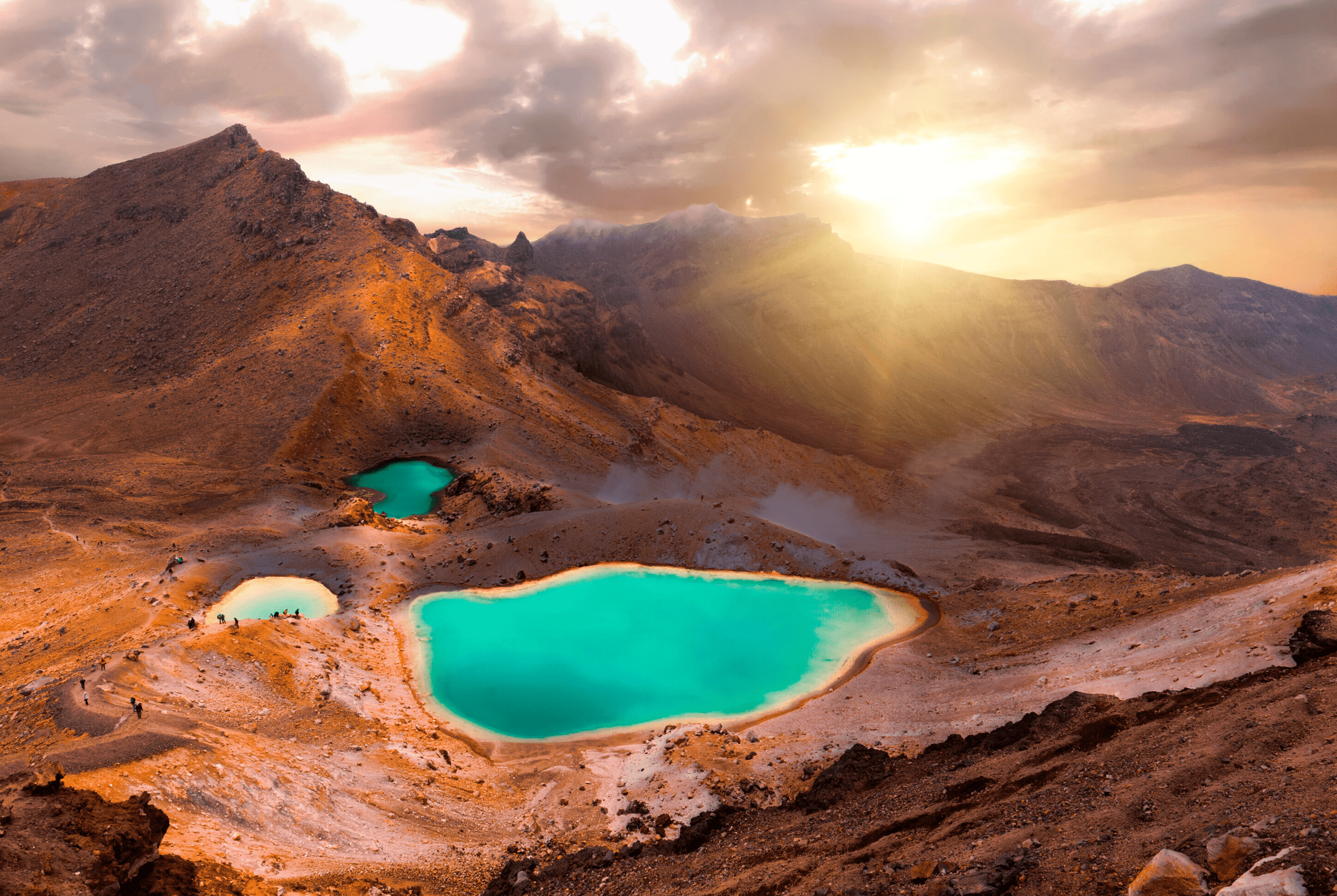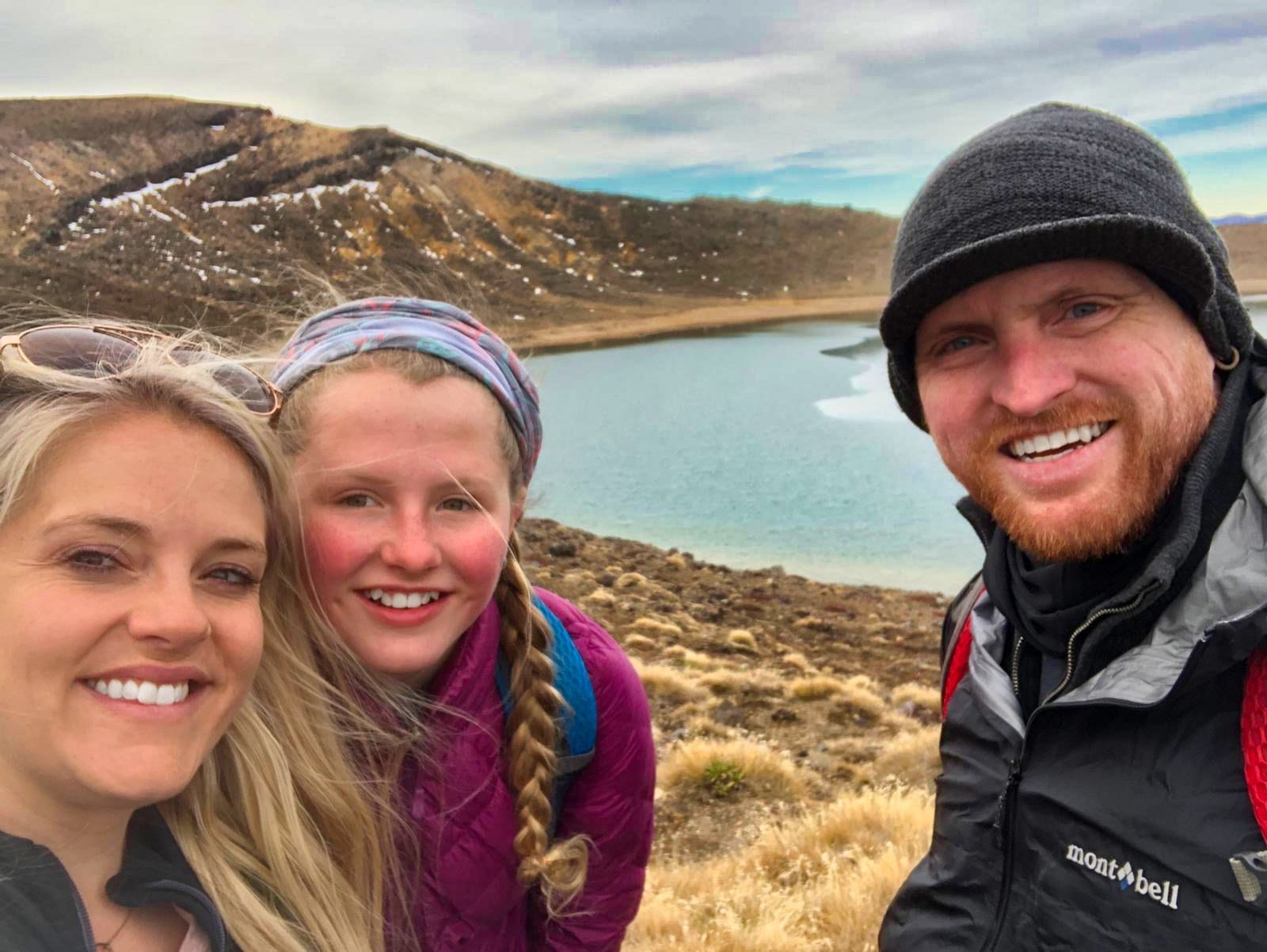

Fanatical hiking, fan or not, the Tongariro Alpine Crossing ranks as one of the best day hikes in the world! Can you do it with kids? Yes, you can! However, there are certain things you should know first.
We have five kids and have been traveling the world full-time for two years. We only opted to take our 12-year-old on this hike because a local advised younger child would not be allowed to go. However, once on the trail, we saw at least a dozen children; most were younger than 12 years old (but not younger than 6-7). You know the limits of your child and their capabilities the best. This hike is difficult, not just a “tramp” through the bush. However, plenty of families do it successfully, and with the right prep, you can knock this day hike off your family bucket list!

*Disclaimer: This post may contain affiliate links. Opinions shared are my own, and I only endorse products I support. By clicking on any of the links below, I may get a small commission if you purchase at absolutely no additional charge to you. I appreciate your support.*
This 19.4 km hike (about 12 miles) takes you through Martian-like landscapes past three volcanos. The most famous volcano, Mount Ngauruhoe, was Mt. Doom in Lord of the Rings. As for LOTR fans, the thought of channeling our inner Frodo and Sam and climbing past Mt Doom was all it took to convince us.
You used to be able to hike Mount Ngauruhoe and Mount Tongariro but are no longer able to. They have been deemed sacred by New Zealand and the Maori people. I’ve heard there are rangers posted to keep people from hiking them. However, when we went (in a very slow season and time), I did spot people climbing them anyway. I find this sad and wouldn’t personally do this or recommend trying. Being a global citizen and a good tourist means respecting the rules and local culture.

This day hike demands a healthy amount of respect from potential hikers. Supremely popular, the trail can host hundreds of people per day. In the summer months, it can be very busy. An estimated 140,000 people hike it every year!
Funny story: we hiked this shortly after the lockdown was lifted for COVID-19 and were told by our shuttle service (more on that below) that we were the only people on the shuttle and the only shuttle for the day. We thought, “we might be the only people on this hike!”. How wrong we were. Despite the tourism environment and being in the early winter of NZ, we were still joined by at least a hundred other hikers on the trail. We were never alone at the beginning of the hike, but we were slow enough to be isolated for about the last 1/3 of the trail.
You might wonder if you are fit enough if you are NOT a world-class hiker or avid trail runner. This hike, in the majority, is a fairly easy walk. However, you gain a lot of elevation (over 800 meters or 2600 feet). This occurs fairly quickly into the hike and is done over several quick gains. This will wear you down.
A steep and dangerous descent through sliding sand/rock is also taxing, but the real kicker for us was the gradual and very long return way down. We felt accomplished and tired by the time we could barely spot the trail’s end. That slog dragged for what felt like a week. It was as mentally taxing and physically difficult after the harder parts of the hike.
We were definitely on the low end of the fitness scale. We never passed anyone and were passed by a lot of people! We did the hike slowly but surely, so chances are good, you can too! We were very sore that night and the next day. All three of us had a lot of pain in our feet (despite great hiking shoes) due to the length. It took us 11 hours (the recommended time is 6-8 hours), so plan extra time if your fitness level is not as high as you might like.
The Tongariro National Park butts up to Turangi, which happens to be where we were already staying. I didn’t even know about this hike when we booked to stay there! This is the best place to stay the night before and maximize your time in the morning. However, staying in Taupo, about 45-minutes away from Turangi and a more “touristy” city, is also totally doable. Check this lodge for an overnight stay.
We spent a few months in Turangi due to the lockdown and fell in love with it in the end. While not a popular destination, it holds a special place in our hearts, and I will be writing more information on what to do there with kids.
The Tongariro Crossing is part of a larger hiking circuit, the Tongariro Northern Circuit, which takes 3-4 days and requires overnight stays in the huts. I am sure there are plenty of camping and RV spots nearby to stay in as well.
Here are some of the accommodations you can also check:
The weather may be your most important factor to consider! Like many hikes, it plays a vital role in your ability to cross the mountains (actually volcanoes!). You cannot and should not complete this trail if the weather turns bad. At key points, pictures of the weather along the trail warn you not to go on.

A friend we made in the area has done the hike twice. He told me it was quite dangerous in bad weather and knew he could easily veer off the trail into dangerous terrain. Pay close attention to the weather forecast, or check with the local I-Site in Taupo or Turangi.
Tip to know about this hike: it is NOT a loop. The start and endpoints of this trail are different and not close to each other. Most of the time, you cannot park your car in the parking lots due to a 4-hour limit. This prevents people hiking the entire trail from parking their cars in the lots.

Because of this, you must find alternate transportation.
If you have your car, you can schedule a shuttle service. We paid around 40 NZ$. You will park your car and lock it (keeping your keys) at the end of the hike and be shuttled to the start point. We found the shuttle service through the Turangi I-Site location, but there are various services and even Airbnbs that can arrange this for you.
If you don’t have your car, shuttles will drop you off and pick you up. They run from 6 am to 4:30 pm and cost around 40-70 NZ$ depending on the return trip and where you are coming from.
The downside of the bus shuttle is that time slots for shuttles must be met. We took much longer to hike the trail than we expected. We were out of shape after lockdown! I was very glad not to have to rush for a timed pickup.
Our shuttle service also has a downside. It was how far away our car was from the trail’s end. We needed to walk an additional 2-3 km at the end, and I was about to collapse on the road. Thankfully, a kind person stopped and offer my husband a ride to the car, so he could come to pick us up. We were so happy to wait there on the road! Sunset had passed long ago, so we sat and stargazed while he went to get the car. With this in mind, having a shuttle at the trail’s end might be nice. The end is similar to a bus stop and has a bench area to wait.
If tour guides add to your comfort zone, you can hire a guide for your hike. We saw multiple groups, some in foreign tongues and others in English, hiking with guides. From what I could tell, hikers paced themselves and could spread out a bit. The guides were there for unexpected emergencies and a bit of coaching. You can expect to pay 150-200 NZ$ dollars for a guide.
We typically do things without tour guides due to our children’s unpredictability and schedules. I would not choose a guide for a hike either, as I would feel pressure to keep up with the group or guide (even if they said it was not a problem!). That plays into my personality.
However, guides can be extremely helpful and cut down on your stress. They do much of the prep work and planning for you, which helps if you are in a time crunch. I saw a guide from this company while on the trail. I can’t speak to a recommendation for them, but it might be a good starting point.
Summer in New Zealand (October to May) is the best time to take this trail. We hiked at the beginning of June and saw snow on the course. With good weather, it was totally fine.
You are encouraged to have crampons and an ice pick during the NZ winter months. Getting a guide might be a good idea for extra safety in the winter months.

Like most hikes, start early! The earliest parking service we could get was 7 am, but I would have started earlier if I could. Bus shuttles start at 6:30 am.
Due to this land being sacred to the Maori, you are asked NOT to relieve yourself on the trail. The NZ Department of Conservation has placed outhouses every 1.5 hours of hiking (according to the 6-8 total hour rule). You need to bring your toilet paper.
I was well aware of this. However, after the first toilet stop, the next two were missing! I am unsure if this was due to the winter season or something else, but I was in a real bind! Only the first and last stops had toilets when we went.
We were told to bring 3L of water per person, which we did. This was a bit much and weighed down our packs. I’d recommend closer to 1.5 L of water per person.
There is no water on the trail for drinking, and it is open to the elements, so if you tend to rehydrate that much, you will need to bring plenty of water.
My pack recommendations:

Driving from Turangi took about 15 minutes to the end parking lot (where we parked our car). The shuttle to the start point took about another 20 minutes. Be sure to check the night before how long your drive will be.
You’ll need to pace yourself and take breaks (unless you are one of those envy-worthy trail runners making the rest of us feel guilty!). There are plenty of signages on the trail to keep you on track. The first half is more physically challenging, but the second half to the end is very long and mentally challenging simultaneously.
Kids might need extra breaks too. Be mindful of your schedule and set a timer when you stop to avoid the break dragging longer. You might get caught in a conversation and spend an hour resting.
The weather is your largest concern on this trail. In foggy/cloudy weather, walking off the trail and falling would be possible. An average of 30-40 people are rescued on the trail each year. There are also deaths each year.
New Zealand has advisories on when the trail should not be hiked, so check ahead and pay attention.
The government of New Zealand occasionally releases Volcanic risk advisory in Tongariro National Park. Be watchful of this too!
With children, additional risks are injury due to playing, being distracted, being sunburnt, and dehydration. Keep water flowing and available to your children, as they are not as good at recognizing dehydration.
If hiking the entire trail is not your thing, you can consider hiking the first half or last half of the course and doing an in-and-out track. Another hiker on the trail told me her mom only hikes from the beginning to the top of the Red Crater, then turns around and returns due to the difficulty on her knees of the descent.
We also saw groups coming from the trail’s end to see the lakes and turn around. This will be a great option if you start too late in the day! I’d pick this over the beginning of the trail.
You can also visit the Tongariro Chateau within the Tongariro National Park and take in some incredible views!
As already mentioned, this sacred land to the Maori people deserves respect. You are asked not to:
I hope this guide will help as your family plans and you get out to enjoy this hike. It will be one of the highlights of your time in New Zealand.
Looking for more activities on the North Island? Check out my friend Jen’s North Island Itinerary for some great ideas!
Post-Covid update: In July 2022, New Zealand finally opened its borders fully after the pandemic. Proof of vaccination is still in the mandate as you enter. But the good news is – there are no quarantine requirements!
XOXO,
Leslie
✈️ Plan and book your flight to New Zealand on Booking.com, Skyscanner, Kiwi.com, or Expedia
Check out hotels near Tongariro from Booking.com, Expedia, or Vrbo, (we also love Tripadvisor)
Look for other fun things to do in central North New Zealand via GetYourGuide, Airbnb Experiences, or Viator
Need a car? Rent from Expedia Rental Cars
✅ Get your family’s travel insurance from World Nomads
Capture your best-hiking memories with a GoPro, Sony camera, or our favorite drones: DJI FPV, Air, and Mini
Check out other travel necessities for your trip from a comprehensive list of all the 7Wayfinders Travel Must-Haves. Click Here!


???? Ultimate Guide To New Zealand: 95 INCREDIBLE Things To Do With Kids
???? Our Favorite Places to Eat in Auckland With and Without Kids
???? Best Things To Do with Kids in North of Auckland

20 Comments